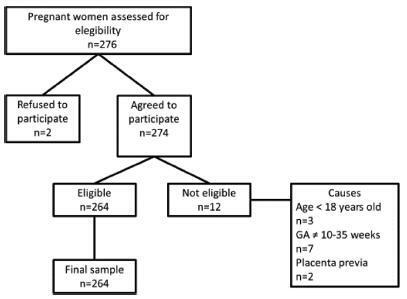Revista Brasileira de Ginecologia e Obstetrícia. 2019;41(9):555-563

To determine the prevalence of sexual dysfunction and its associated factors in pregnant women.
A descriptive, cross-sectional study including 262 pregnant women aged 18 years or older with gestational age between 10 and 35 weeks. Women with urinary tract infections and conditions of gestational risk were excluded. The Pregnancy Sexual Response Inventory (PSRI) questionnaire was used. We performed a univariate descriptive analysis, and comparisons between the mean values of the sexual function domains were made using the Student t-test. The chi-squared test was used to determine the association between the independent and dependent variables. The prevalence ratios, with their respective 95% confidence intervals, were also estimated, and a multivariate analysis was performed.
A total of 64.9% of women reported a decrease in the frequency of sexual activity during pregnancy. Slightly more than half of the women (50.8%) were satisfied, and arousal was reported as excellent/good by 30.5% of them. The frequency of sexual difficulties/dysfunctions increased with pregnancy, rising from 5.7% to 58.8%, and pain during sexual intercourse was reported by 45.8% of them. Having higher education degree decreased the chance of being sexually dissatisfied by 50%. The total PSRI score showed a significant decrease from the prepregnancy period (mean score = 89.8, “excellent”) to the pregnancy period (mean score = 59.2, “good”).
The mean sexual function score during pregnancy was classified as good, although most pregnant women reported at least one type of alteration in the sexual function domains, and the report of dissatisfaction was more frequent in women with lower schooling.
Search
Search in:


Comments